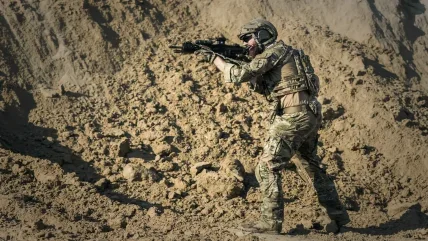
The development of Brazil’s COBRA project began in mid-2013, and is a cooperative by-product of a joint working group with France created by the South American nation’s Ministry of Defence to identify cooperative opportunities in defence between it and other countries with which it has established treaties.
"France had a very important role in the studies realised for this project up until now," says Colonel Elivaldo João Rossi, strategic project supervisor for the Brazilian Amy’s project for the Recovery of Operational Capacity (RECOp), under which COBRA is being managed.
"COBRA has been a cooperative project, and we searched for concepts (in the French armed forces) that would allow the Brazilian Army to initiate its own future soldier.programme. Having said that, COBRA will not be a copy of any other future soldier programme: it will be a new solution entirely planned and implemented by the Brazilian Army."
As of December 2014, the general staff of the Brazilian Army has been working on project implementation guidelines so that research and development work on the COBRA scheme can be initiated.
Since the project is still in a pre-R&D phase, Brazil’s armed forces have declined to discuss in detail any similarities or differences that might exist between COBRA and other future soldier programmes currently being pursued around the world.
Collaborative process
The close relationship that Brazil’s Ministry of Defence enjoyed with France during this programme’s early development, and the regular urban deployment of Brazilian armed forces in recent years, however, can help forecast what the South American nation’s military may be looking for in terms of cutting-edge equipment for its future soldiers.
France’s FÉLIN is an integrated infantry system that enhances close-combat mobility, lethality, survivability and command, control, computers and information (C4I), making French dismounted soldiers among the best-equipped ground forces in the world.
COBRA is expected to be similar to the FÉLIN combat systems used since 2010 by the French military. In development and roll-out from 1997 through to 2010, FÉLIN has included a modified Famas rifle with advanced electronics, clothing, pouches and body armour, as well as a Spectra helmet that features a real-time information and positioning system and light amplifiers for night vision.
It provides infantry soldiers with enhanced combat abilities, but FÉLIN also sports design features that focus on flexibility and human centrality for the dismounted soldier. Ergonomics and intuitiveness are key in every aspect of how the technology can be accessed and used.
Brazil will be able to use technology similar to FÉLIN in its COBRA programme to enhance infantry observations, communications, command, coordination and engagement. The Brazilian Army may find the technology most useful in the domestic urban zones that it has been called into on a regular basis in recent years to help domestic police.
Complexo problem
Brazil’s armed forces were tasked with taking control of the Complexo do Alemão slum in Rio de Janeiro’s North Zone in November 2010, when an urban war broke out after law enforcement initiated a coordinated effort to drive drug dealers out of the city’s slums. Army troops only officially withdrew from Complexo do Alemão in June 2012.
More recently, Brazilian armed forces were brought back to the slums of Rio de Janeiro in March 2014, following attacks on police bases coordinated by the city’s most prominent gang.
Army troops were also called in to reinforce security in the FIFA World Cup host city of Recife in May 2014, just weeks before the tournament was set to begin, after the city’s murder rate and looting spiked when local police went on strike for a pay rise.
Greater protection
The COBRA project will give more protection to Brazilian soldiers through tools used for proactive response and monitoring. The programme is expected to integrate night vision with amplifying technology and holographic sight.
Other equipment that may be included in the final version includes improved optronics and digital radio, integration with computer tablets that should use GPS technology to monitor soldiers and their use of ammunition, as well as sensors on the body that could relay live health data to company commanders.
Workshops, lectures, site visits and demonstrations were all ways that France has aided the Brazilian Army over the past year in researching the potential routes down which to take its COBRA programme.
Brazil has also discussed the programme at length with leading manufacturers of military-grade equipment that have had a hand in other future soldier programmes around the world, though Rossi declined to name those companies.
Five-year plan
Colonel Rossi estimates that Brazil’s COBRA programme will have a five-year development cycle, and that the first version of field-ready equipment could be implemented around 2020.
Companies have not been contracted yet, due to the current phase of the project, he confirms, and the resources necessary for its development are still to be ordered.
"The first version of COBRA should be distributed primarily to operating troops in infantry and cavalry divisions," Rossi adds.
"COBRA will probably then have different versions adapted to the various operating environments, in
the event of its use."



